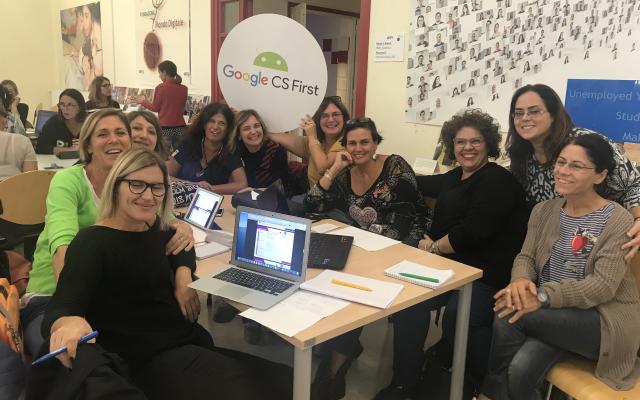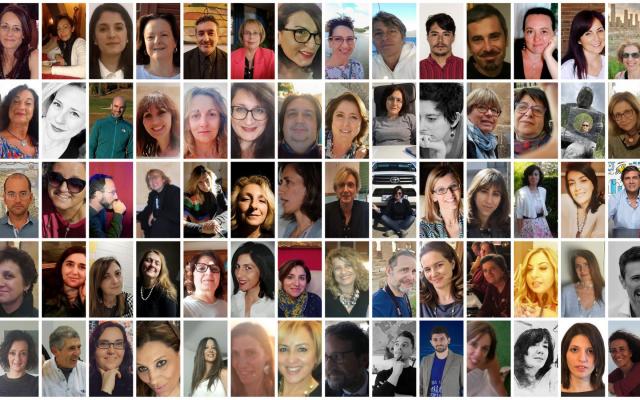How to develop computational thinking with the CS First Platform.
Barbara Avella and Mauro Crepaldi, who are both very active in the “Our School” Professors Community, have followed project CS First right from the outset as teacher trainers. They have often been protagonists of the training sessions and were happy to share their didactic experience in this double interview with Onelia Onorati.
Barbara Avella: “I learned about the project right from the outset. I think it was June 2018. I found it very interesting that one could have groups of students work independently, overcoming the limits imposed by the small number of devices present at the school, but also being able to follow individual students thanks to the teacher's dashboard. At first, when I was working with older students, I was able to dedicate a lot of time to it while, in the following years, between the pandemic and a younger class group, I had less opportunity, although I never interrupted its use.”
Mauro Crepaldi: “My relationship with programming as a primary school teacher began when only “turtles” moved on PCs, which, with corresponding slowness, accompanied us to the “kitten” (symbol of Scratch) that brought the real, great upheaval in the world of coding, moving from an almost completely procedural and scholastic use to a design and expressive one. I was there from the first Italian edition of CS First proposed by FMD which, at the time, represented a precious unicum with its tutorials, dedicated to students, “set” in a platform designed for the needs of their teachers (many completely unfamiliar with block-based visual programming).”
What do you think about the platform?
BA: “I find it a very useful tool to focus activities on the student and/or the class, enhancing the characteristics of each and respecting everyone’s learning times. On the other hand, it is also possible to organise activities for small groups of 3-4 students in order to improve their ability to work together. I have only observed, working with many students, that the instructions alongside the tutorials are often neglected due to the students’ tendency to avoid reading texts. They prefer images and videos, but this places the correct workflow at risk. By changing computers, the accounts created become anonymous; moreover, the activity reports are very useful, both to teachers and students, as they allow monitoring of progress, self-assessment, and transparent and objective evaluation of student effort
MC: “CS First is a complete, scalable, and consolidated learning platform. Perhaps the only thing that could still be improved would be the possibility of "accompanying" the students who were lucky enough to have used it in primary school towards the application of block coding and the cards and extensions available in Scratch, as well as towards the integrated use of artificial intelligences that could truly represent a turning point in the translation of visual programming into more complex languages (obviously if the educational objective is not pure programming).
How is the platform an added value for teaching, both from the teachers' and students' points of view?
BA: “The platform is free and accessible to everyone. It allows teachers to take their first steps in programming, supporting the teaching of computational thinking and basic programming skills. It is engaging and stimulating, so it promotes the learning of coding even for students with no experience. Moreover, it is well structured with regard to the development of computational thinking (problem posing and problem solving) and creative thinking. Finally, it also promotes creativity and personal expression and supports attitudes that favour effective learning, such as persistence, open-mindedness, collaboration, and communication.”
MC: “Compared to the past, there now is a more varied choice of platforms but CS First still maintains a competitive advantage with its strong recognition programme (badges, certificates, etc.), and it is loved by both young students and teachers for the high motivation it generates in class.
Can an inclusive platform be definitive, for everyone, regardless of cultural differences?
BA: “I have not had the opportunity to test whether the tutorials are available in different languages. Scratch certainly provides – as I have verified this with a class in the past – the possibility of working even with children who do not speak Italian. In this sense, the activity was effectively inclusive: a child coming from an Arab country and completely unfamiliar with Italian was constantly involved in the group work, managing to relate to her classmates, and gradually learning a bit of Italian.”
What feedback have you received from the training sessions?
BA: “To overcome the difficulties related to the lack of basic digital skills that risked slowing down the group or leaving someone behind, I proposed training on two or three levels, beginning from basic. We addressed accounts, passwords, and basic-level platform features; in the medium level, we worked on some of the more complex units; in the high level, we turned to thinking about the use of reporting and proposing interdisciplinary coding courses (combining two or more subjects).”
MC: “It is sometimes difficult, in the Italian school landscape, which characterized by the high average age of teachers and a low digital literacy level, to make people perceive the advantages that a platform provides in terms of inclusiveness both for the most fragile students and those who are not Italian “mother tongue,” an increasingly numerous category in our country. Those who, like us, take CS First into schools easily perceive it in the eyes of the colleagues who understand the scope of the project but remain "white flies" in their own institute where, perhaps, the only way to interpret coding is still the procedural one (the Code.Org model, to be clear). This, however, tends to highlight the cultural and irrational divide between subjects in the anthropological-expressive area and those in the mathematical-scientific area.”
So, there is a lot of room for improvement. Nonetheless, this project still manages to provide a different approach to teaching and represents a good first step towards greater and more complete basic literacy.





